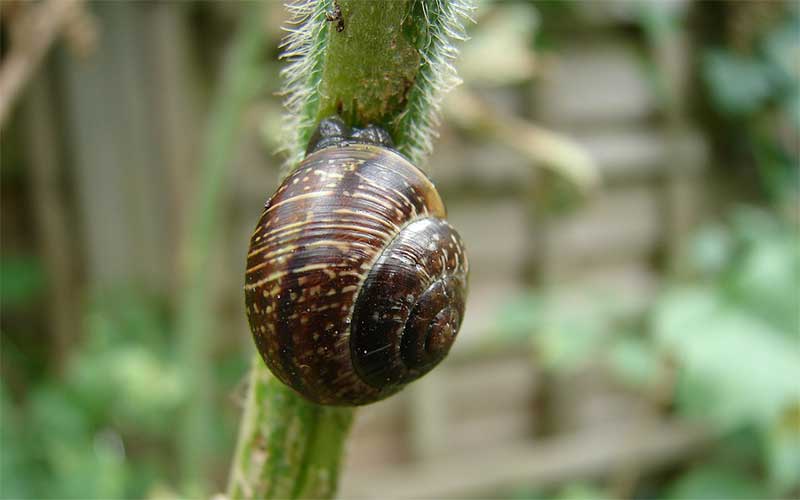Males or females?
Reproduction of non-mammalian animals catches the attention of some people because they usually are unique processes. Snails have a striking appearance, but their reproductive habits are also uncommon. One of the keys to snail survival through time are the characteristics of their reproduction process.
The first thing you should know about these terrestrial gastropod mollusks is that most are hermaphrodites. Hermaphrodite is called any organism that has male and female reproductive organs and therefore can produce both eggs and spermatozoa. It is like if the snails were male and female at the same time.
There are, however, exceptions. The snails of the family Pomatiidae differ from their relatives because they have separated genders, that is to say, each snail is either a male or is a female according to the reproductive organs that it possesses. It is relatively easy to recognize the gender since the species present sexual dimorphism: the shell of males is smaller than females.
Most terrestrial gastropods are hermaphrodites, but some snails do not have this attribute, specifically some freshwater snails like the Apple Snails and periwinkles. These two types of snails still have separate male and female individuals.
The reproductive system ends in an external opening located in the lower part of the body near the head, called the genital pore. Individuals reach sexual maturity at different ages, according to their species and their particular conditions. Once they are sexually mature, their sex organs acquire the necessary conditions to reproduce, but they can begin to mate later. Usually, land snails reach maturity between 6 weeks and five years of age. Some mature sooner or later if the conditions of their external environment are favorable or not to their development.
Courtship: what to do to get noticed?
When a snail is already mature can begin mating, that is clear, but how do they approximate each other?
Before the intercourse, both approach to start the courtship process consisting of a series of movements and attitudes that will finish or not in the mating. The entire process can last as little as 2 hours or as long as 12 hours. To find a partner, they primarily rely on their sense of smell and touch, as their visual capacity is poorly developed and devoid of hearing. They can recognize chemicals in the air that communicate the receptivity of some other snail nearby.
During the process, both land snails get closer, acknowledging each other and “testing the odds.” As they approach, they begin to interact in a more physical way and can touch each other with the help of their tentacles. Some move in circles and can bite the area of the genital pore.
In the final stage of courtship and before mating, some species use a unique weapon: the “love darts.” No, it is not a metaphor, it is a structure of calcium or chitin that only sexually mature snails have, and usually that have mated more than once. Seen in detail, they indeed resemble pointed darts.
When both are close enough and touch their genitals, they shoot their love darts. Darts are not fired away but are a contact shot. Usually, the two snails shoot the structures, and they pierce the skin of the other so that they are united. The dangerous thing about this is that sometimes darts can damage an internal organ or go through the body and exit on the other side.
The function of love darts is not transferring sperm but is a form of sexual selection, and observations concluded that garden snails (Helix aspersa) could increase their reproductive success. The mucus that covers a dart contains a type of hormones capable of increasing the chances of success to have offspring.
Mating
After the snails shoot their “love darts,” copulation follows. The transfer of sperm through the penis may be reciprocal or unilateral; this means that either both transfer it, or just one of the snails. It depends on the species. Others prefer to self-fertilize, so they do not need another individual to lay eggs.
After fertilization, the eggs go through a process of growth inside the snail, until they are ready to be delivered. After that, both snails lay their eggs and bury them in separate places inside a small hole made in the topsoil in a cool place. The mating process of snails allows them to deliver eggs at a consistent rate.
It will typically take a snail egg two to four weeks to develop. (1) As soon as they hatch, they will immediately move into a survival mode, because their shells still are soft. Their first reaction as soon as they hatch is to find sources of calcium either eating the remainings of their egg or eating other eggs that have not hatched to get the extra nutrients.
In conclusion, the mating process of snails starts when reaching sexual maturity, followed by finding the right partner, copulating, locating and creating a place to deliver the eggs, hatching of the eggs and ending with the develop of small snails.
Sources:
http://scienceline.ucsb.edu/getkey.php?key=2578
Animals, a visual encyclopedia. Second edition. Smithsonian 2012.
http://www.molluscs.at/gastropoda/index.html?/gastropoda/morphology/reproduction.html
http://news.nationalgeographic.com/2015/03/150310-snails-reproduction-sex-animals-science-evolution/
BioExpedition Publishing © 2017.




